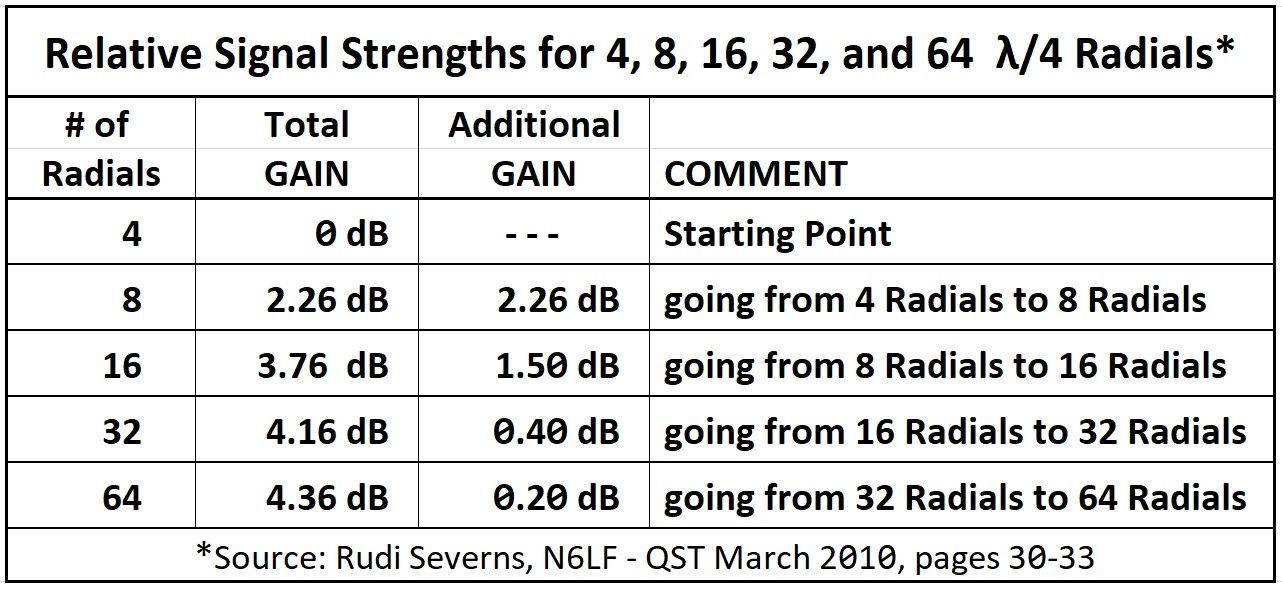R A D I A L S
"Radials" play an important role in the efficiency of antennas that need them!
What's below the antenna is just as important as the antenna itself!
"Radials" may seem like a simple topic, but there is actually a lot more to this topic than one might think. This page is an overview of what I recommend doing. I will show links to detailed information supporting my suggestions.
Although the consensus is that radials should be 1/4 wavelength long, this is not always true. There are solid reasons for sometimes making radials a different length.
There are two types of radials: "Ground Radials" and "Resonant Elevated Radials".
Here are some guidelines when planning your radial network:
Elevated Radials:
- Elevated Radials MUST be resonant 1/4 wavelength long.
- Each elevated radial is approximately equivalent in performance to 8 ground radials.
- 2 Elevated radials gives you about the same performance as 16 ground radials.
- Elevated radials must be kept away from metal objects. Otherwise, they will be detuned.
- Although 1 meter (abt. 3 ft.) height above ground will suffice, I try to keep mine about 8 ft. above ground so as not to be easily reached by humans or animals
- Multiple elevated radials should be spaced equal-distance from each other, around the radiator.
Ground Radials:
- Ground Radials may be resonant 1/4 wavelength long, but they may also be shorter; even as short as 1/8 wavelength long and still be effective.
- Avoid 1/2 wavelength radials.
- These present a high impedance to the antenna and simply do not work.
- In general, multiple short radials works better than fewer long radials.
- With the same amount of wire, eight 1/8 wavelength radials will be more efficient that four 1/4 wavelength radials.
- There are cases where shorter radials have more gain than 1/4 wavelength radials.
Relative Gain when Increasing the Number of Radials:

The chart above shows the relative gain achieved when adding additional radials beneath a full-size quarter-wave vertical.*
Diminishing Return on Investment: as you see, adding more radials initially adds a lot of gain, but as we continue to double the number of radials, the amount of additional gain diminishes rapidly.
*Note: the specific results shown above only apply to a full size vertical. When using shortened vertical radiators (i.e. with inductive loading, capacitive loading, or linear loading), the amount of additional gain increases somewhat more than the values shown in the chart above. For more information on this, read the original QST article from N6LF.
Improving Gain by using Short Radials:
The information below is somewhat surprising. Again it pertains to radials used together with a full-size quart-wave vertical.

With just 4 radials, shortening the radials from 33 ft. to 21 ft. increases the relative signal strength by 3.08 dB! With 8 radials it increases another 1.42 dB. Adding more radials beyond that gives us very little additional gain.
For portable operation where we must put up (and take down) the antenna in a short amount of time, using 8 short radials (i.e, 21 ft. on 40m) gives us about the same signal strength as when using 16 quarter-wave radials.
LINK to N6LF Article: https://rudys.typepad.com/files/qst-march-2010-ground-systems.pdf
CONCLUSION:
Although a vertical antenna (or Inv.-L) is a good solution when space is highly limited, if you fail to install a decent radial network beneath the vertical radiator, you may be very disappointed in the performance.
The information on this page will help you to plan your radial network. Do not be fooled by articles claiming you need 100+ radials to achieve good performance. THAT IS FAKE NEWS!
We often read where someone suggests using just a ground stake instead of radials. This is ridiculous and similar to taking a bicycle on a 1000 mile road trip instead of a motorcycle.
Wire is not cheap. Labor is perhaps cheap (if you have the time) but considering the diminishing return on investment for the number of radials, in most cases 8 to 16 radials is probably your best option. It doesn't hurt performance to add more radials . . . but it comes with an ever increasing cost per dB.
